by Nikole Elli | November 7, 2021
The push for digitalization is strong these days. Everything is one tap away. And this technological revolution includes the convenience of online shopping through our phone screens. Unsurprisingly, e-commerce companies are getting better and better at marketing their products as they offer monthly sales, big discounts for bulk purchases, and the come-ons of “free shipping” vouchers. With the barrier of distance removed, orders only just a week or two away, online shopping also poses a threat to plastic pollution as the packaging that reaches the customers is not easily recyclable.

Amazon, for one, generated 465 million pounds of plastic packaging waste in 2019. According to Vox, the company’s number of air pillows alone could circle the globe 500 times. Oceana’s research led their senior vice president Matt Littlejohn to say that “plastic packaging and waste generated by Amazon’s packages are mostly destined, not for recycling, but for the landfill, the incinerator, or the environment including, unfortunately, our waterways and sea where plastic can harm marine life”. Still, Amazon claims that the research is “dramatically miscalculated” by over 350%.
Regardless of Oceana’s calculation as opposed to Amazon’s claim, plastic waste inevitably increased in 2020 at the height of the pandemic. Though the world may be slowly settling down as the pandemic slows, online shopping cannot seem to be stopped anytime soon.
The season for shopping is once again just around the corner. Since Christmas is coming up, the deals are once again increasingly promising and tempting. Demands for gifts and whatnots will surge again. And unsurprisingly, the problem with your package encompasses a far bigger problem than plastic pollution.
If you think about it, how does that package reach your doorstep exactly? It undergoes various steps for transportation and storage. Since logistics companies choose cheaper options, these may not be the most sustainable ones.
Trends may dictate what’s new and you may easily be swayed by product promotions that are constantly being thrown at you in this digital age. However, it is vital not to be easily consumed by what the internet feeds. So, the next time you “add to cart”, rethink if it’s worth purchasing… if it’s worth spending another plastic packaging on.


